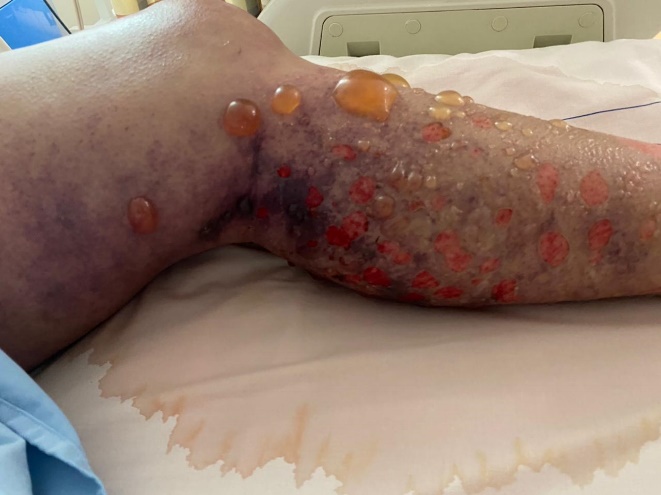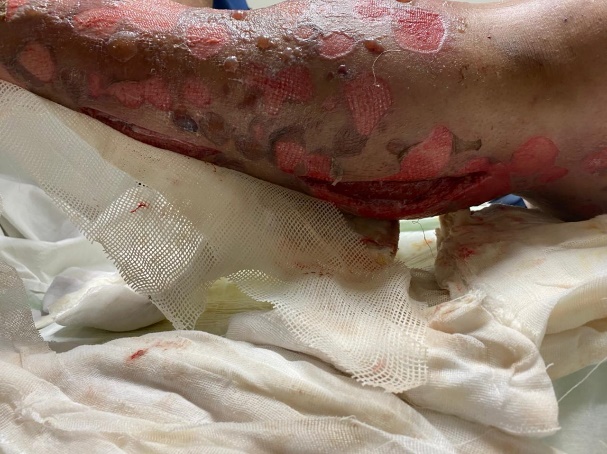Clinical Research and Clinical Case Reports
OPEN ACCESS | Volume 6 - Issue 2 - 2025
ISSN No: 2836-2667 | Journal DOI: 10.61148/2836-2667/CRCCR
Ayman M. Fakhry1, Sohiel A. Nagib2
1Professor of vascular surgery, Egyptian medical military academy 2Senior registrar of vascular and endovascular dept., Alexandria Armed Forces hospital
*Corresponding author: Ayman M. Fakhry, Professor of vascular surgery, Egyptian medical military academy.
August 02, 2021Received:
Accepted: August 27, 2021
Published: August 31, 2021
Citation: Ayman M. Fakhry, Sohiel A. Nagib. “Fasciotomy in extensive left iliofemoral deep vein thrombosis – Case report”. Clinical Research and Clinical Case Reports, 2(1); DOI: http;//doi.org/04.2021/1.1028
Copyright: © 2021 Ayman M. Fakhry. This is an open access article distributed under the Creative Commons Attribution License, which permits unrestricted use, distribution, and reproduction in any medium, provided the original work is properly cited.
,
Compartment syndrome following venous thrombosis is rare with only a few reported cases of acute massive venous thrombosis. (1) It occurs when muscle compartments bounded by an unyielding fascial layer have increased pressure leading to neurovascular compromise and subsequent necrosis of the tissue. Here we report a similar case of compartment syndrome following iliofemoral vein thrombosis. (2)
A 45-year-old female presented to the Royal Vascular Center with a three-day history of extensive left lower extremity swelling and pain. On exam, vital signs were within normal except systolic blood pressure was 150/100 mm Hg. The left lower extremity appeared erythematous with visible swelling up to mid-thigh, non-pitting firmness on palpation, severe tenderness, and pain on left calf squeezing with multiple vesicles over the left leg and foot. Dorsalis pedis and posterior tibialis pulses were not palpable but were present on Doppler. Fig 1


Fig. (1) Extensive tens and tender left leg edema with multiple leg vesicles
She complained of paresthesia and numbness of the lateral left lower leg and she denied any history of trauma. Duplex of lower extremity demonstrated a new non-occlusive thrombus extending from the left external iliac vein & common femoral vein through the distal femoral vein to the calf veins. Soft tissue ultrasound didn’t show any fluid collection nor hematoma of both left leg and thigh and normal muscular configuration Patient had a recent history of cancer colon and on chemotherapy for three weeks after right hemicolectomy Diagnosis of compartment syndrome was made clinically and therefore was taken to the operating room for emergent medial & lateral leg fasciotomy. Fig 2


Fig. (2) Medial and Lateral fasciotomies (arrows)
She was appropriately anti-coagulated., autologous skin grafting was done with good results.
Discussion: Increased compartment pressure following venous occlusion due to extensive thrombosis of the lower extremity is a rarely known process according to Ankush et. (1). Trauma and blood accumulation in the compartmental space of the leg but atraumatic case following deep vein thrombosis occurred in few cases according to Germanous et. Al. (3) and this was the case we presented without a history of trauma nor muscular tear. Adelman et.al. & Hay et.al. (4&5) reported few cases of few muscular tears in the calf region and when they were fully anticoagulated, they develop high compartmental pressure secondary to blood accumulation in tissue spaces and this was not the case in our patient as no muscular tear nor fluid were present in soft tissue ultrasound examination. Though it is a rare complication of deep vein thrombosis, it is important to consider this syndrome when DVT presents with classical findings of compartment syndrome and emergent fasciotomy is the mainstay of treatment for compartment syndrome that we had already done in our case. The patient did well and successfully we could preserve the limb and also the lady regained the normal sensation and motor power a few hours after few hours this was in agreement with Dhayalan et.al. (2) when they reported the same result in dealing with their patient. Treatment with full anticoagulation and other therapeutic options like thrombolytic therapy and venous thrombectomy is reserved for massive thrombosis after managing the increased compartmental pressure.
Conclusion: Doctors should be aware of this unusual (but treatable) complication of DVT and have a low threshold for investigating pain disproportionate” to the expectations. When there are clear signs of ACS in an appropriately anticoagulated patient, urgent fasciotomy should be considered. Untreated ACS is potentially limb-threatening. When DV Tis the cause of the ACS its appropriate management is important about the duration of anticoagulation.